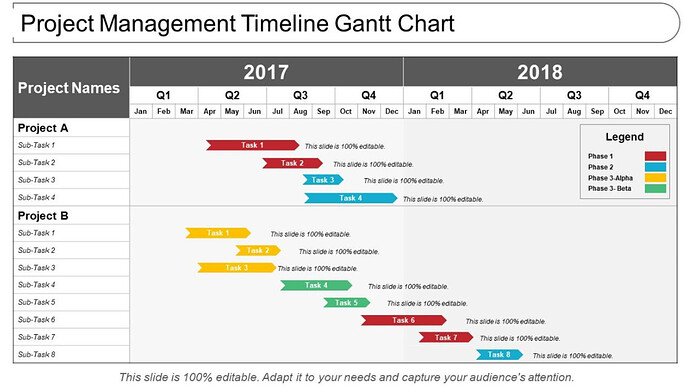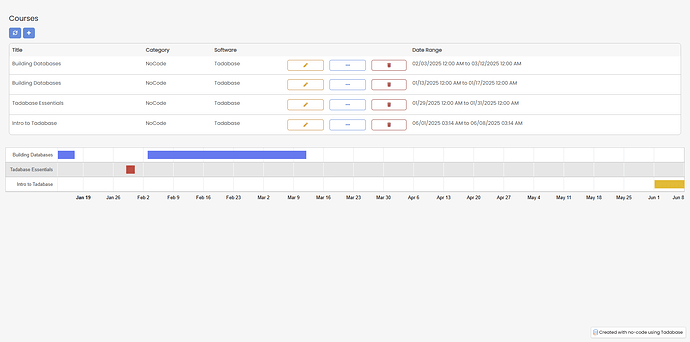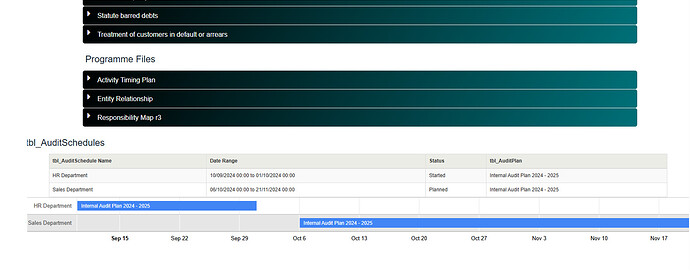@Shumon
I’ve created a basic demo code using Google Timeline Chart based on your design. I thought this might be helpful to you.
<!DOCTYPE html>
<html>
<head>
<script type="text/javascript" src="https://www.gstatic.com/charts/loader.js"></script>
<script type="text/javascript">
google.charts.load('current', { packages: ['timeline'] });
google.charts.setOnLoadCallback(drawChart);
function drawChart() {
const container = document.getElementById('timeline');
const chart = new google.visualization.Timeline(container);
const dataTable = new google.visualization.DataTable();
// Define columns
dataTable.addColumn({ type: 'string', id: 'Project' });
dataTable.addColumn({ type: 'string', id: 'Task' });
dataTable.addColumn({ type: 'date', id: 'Start' });
dataTable.addColumn({ type: 'date', id: 'End' });
// Add rows (Dynamically fetched data can be added here)
const rows = [
['Project A', 'Sub-Task 1', new Date(2017, 0, 1), new Date(2017, 2, 31)],
['Project A', 'Sub-Task 2', new Date(2017, 3, 1), new Date(2017, 5, 30)],
['Project A', 'Sub-Task 3', new Date(2017, 6, 1), new Date(2017, 8, 30)],
['Project A', 'Sub-Task 4', new Date(2017, 9, 1), new Date(2017, 11, 31)],
['Project B', 'Sub-Task 1', new Date(2017, 0, 1), new Date(2017, 1, 28)],
['Project B', 'Sub-Task 2', new Date(2017, 2, 1), new Date(2017, 4, 31)],
['Project B', 'Sub-Task 3', new Date(2017, 5, 1), new Date(2017, 6, 31)],
['Project B', 'Sub-Task 4', new Date(2017, 7, 1), new Date(2017, 8, 30)],
['Project B', 'Sub-Task 5', new Date(2017, 9, 1), new Date(2017, 10, 30)],
['Project B', 'Sub-Task 6', new Date(2017, 11, 1), new Date(2018, 0, 31)],
['Project B', 'Sub-Task 7', new Date(2018, 1, 1), new Date(2018, 2, 31)],
['Project B', 'Sub-Task 8', new Date(2018, 3, 1), new Date(2018, 4, 31)],
];
dataTable.addRows(rows);
// Chart options
const options = {
timeline: {
groupByRowLabel: true,
rowLabelStyle: { fontSize: 14, bold: true },
barLabelStyle: { fontSize: 12 },
},
colors: ['#e74c3c', '#f39c12', '#3498db', '#1abc9c'],
};
chart.draw(dataTable, options);
// Generate dynamic quarters
const startYear = Math.min(...rows.map(r => r[2].getFullYear()));
const endYear = Math.max(...rows.map(r => r[3].getFullYear()));
generateDynamicQuarters(startYear, endYear);
}
// Function to generate dynamic quarters
function generateDynamicQuarters(startYear, endYear) {
const quarterContainer = document.querySelector('#quarters');
quarterContainer.innerHTML = ''; // Clear any existing quarters
for (let year = startYear; year <= endYear; year++) {
for (let quarter = 1; quarter <= 4; quarter++) {
const quarterDiv = document.createElement('div');
quarterDiv.textContent = `Q${quarter} ${year}`;
quarterDiv.style.padding = '10px';
quarterDiv.style.borderRight = '1px solid #ccc';
quarterDiv.style.textAlign = 'center';
quarterContainer.appendChild(quarterDiv);
}
}
}
</script>
<style>
body {
font-family: Arial, sans-serif;
margin: 0;
padding: 0;
background-color: #f9f9f9;
}
h1 {
text-align: center;
font-size: 24px;
margin-top: 20px;
color: #333;
}
.container {
width: 90%;
margin: 20px auto;
}
/* Header for Project Names and Quarters */
#custom-header {
display: grid;
grid-template-columns: 1fr 8fr;
background-color: #ddd;
border: 1px solid #ccc;
text-align: center;
font-weight: bold;
font-size: 14px;
}
#custom-header > div {
padding: 10px;
border-right: 1px solid #ccc;
}
#quarters {
display: grid;
grid-template-columns: repeat(auto-fit, minmax(100px, 1fr));
}
#timeline {
height: 600px;
margin-top: -5px; /* Align with header */
}
/* Legend Styling */
#legend {
width: 90%;
margin: 20px auto;
display: flex;
justify-content: flex-end;
font-size: 14px;
}
.legend-item {
display: flex;
align-items: center;
margin-left: 20px;
}
.legend-color {
width: 16px;
height: 16px;
margin-right: 5px;
border: 1px solid #ccc;
}
.phase-1 {
background-color: #e74c3c;
}
.phase-2 {
background-color: #f39c12;
}
.phase-3-alpha {
background-color: #3498db;
}
.phase-3-beta {
background-color: #1abc9c;
}
</style>
</head>
<body>
<h1>Project Management Timeline Gantt Chart</h1>
<div class="container">
<!-- Custom Header -->
<div id="custom-header">
<div>Project Names</div>
<div id="quarters"></div>
</div>
<!-- Google Chart -->
<div id="timeline"></div>
</div>
</body>
</html>



